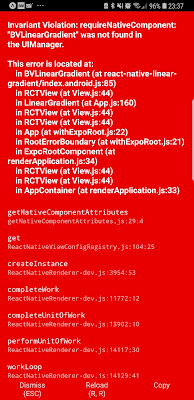Software Required
-
NPM version 6.4.1
-
expo version 2.6.14
-
Atom 1.34.0
-
NativeBase 2.10.0. Please refer to link
Problems
- Follow the sample tutorial provided by NativeBase and encounter error message as shown below.
Error: Error: The <image> component cannot contain children. If you want to render content on top of image, consider using the <ImageBackground> component or absolute positioning.
- Troubleshoot the source code and discovered that the Image component in SideBar.js that caused the error message
import React from "react";
import { AppRegistry, Image, StatusBar } from "react-native";
import { Container, Content, Text, List, ListItem } from "native-base";
const routes = ["Home", "Chat", "Profile"];
export default class SideBar extends React.Component {
render() {
return (
<Container>
<Content>
<Image
source={{
uri: "https://github.com/GeekyAnts/NativeBase-KitchenSink/raw/react-navigation/img/drawer-cover.png"
}}
style={{
height: 120,
alignSelf: "stretch",
justifyContent: "center",
alignItems: "center"
}}>
<Image
square
style={{ height: 80, width: 70 }}
source={{
uri: "https://github.com/GeekyAnts/NativeBase-KitchenSink/raw/react-navigation/img/logo.png"
}}
/>
</Image>
<List
dataArray={routes}
renderRow={data => {
return (
<ListItem
button
onPress={() => this.props.navigation.navigate(data)}>
<Text>{data}</Text>
</ListItem>
);
}}
/>
</Content>
</Container>
);
}
}
Steps
- Obviously, Image component as shown in the section below that caused the problem.
render() {
...
<Image
source={{
uri: "https://github.com/GeekyAnts/NativeBase-KitchenSink/raw/react-navigation/img/drawer-cover.png"
}}
style={{
height: 120,
alignSelf: "stretch",
justifyContent: "center",
alignItems: "center"
}}>
...
);
}
}
- I fixed the issue with ImageBackground as shown in the section below, it works like a charm
import React from "react";
import { AppRegistry, Image, StatusBar, ImageBackground } from "react-native";
import { Container, Content, Text, List, ListItem } from "native-base";
const routes = ["Home", "Chat", "Profile"];
export default class SideBar extends React.Component {
render() {
return (
<Container>
<Content>
<ImageBackground
source={require("../../images/drawer-cover.png")}
style={{
height: 120,
alignSelf: "stretch",
justifyContent: "center",
alignItems: "center"
}}>
<Image
square
style={{ height: 80, width: 70 }}
source={require("../../images/logo.png")}
/>
</ImageBackground>
<List
dataArray={routes}
renderRow={data => {
return (
<ListItem
button
onPress={() => this.props.navigation.navigate(data)}>
<Text>{data}</Text>
</ListItem>
);
}}
/>
</Content>
</Container>
);
}
}












